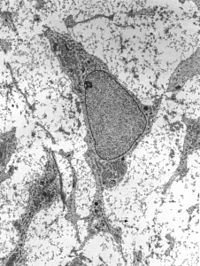
Photo from wikipedia
Multicellular tissues are continually turning over, and homeostasis is maintained through regulated proliferation and differentiation of stem cells and progenitors. Following tissue injury, a dramatic increase in cell proliferation is… Click to show full abstract
Multicellular tissues are continually turning over, and homeostasis is maintained through regulated proliferation and differentiation of stem cells and progenitors. Following tissue injury, a dramatic increase in cell proliferation is commonly observed, resulting in rapid restoration of tissue size. This regulation is thought to occur via multiple feedback loops acting on cell self-renewal or differentiation. Models of ordinary differential equations have been widely used to study the cell lineage system. Prior modeling studies have suggested that loss of homeostasis and initiation of tumorigenesis can be contributed to the loss of control of these processes, and the rate of symmetric versus asymmetric division of the stem cells may also be altered. While most of the previous works focused on analysis of stability, existence and uniqueness of steady states of multistage cell lineage models, in this work we attempt to understand the cell lineage model from a different perspective. We compare three variants of hierarchical stem cell lineage tissue models with different combinations of negative feedbacks and use sensitivity analysis to examine the possible strategies for the cells to achieve certain performance objectives. Our results suggest that multiple negative feedback loops must be present in the stem cell lineage to keep the fractions of stem cells to differentiated cells in the total population as robust as possible to variations in cell division parameters, and to minimize the time for tissue recovery in a non-oscillatory manner.
Journal Title: Journal of theoretical biology
Year Published: 2018
Link to full text (if available)
Share on Social Media: Sign Up to like & get
recommendations!